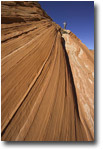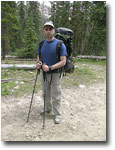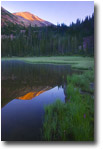 |
 |
||||
Brett Weston once joked that anything more than 500 yards from the car just isn't photogenic. He was referring to photography with an 8x10 view camera and though many landscape photographers may disagree with the sentiment, I’m sure most can relate to the draining effect that extended physical exertion can have on creative photography while on long hiking or backpacking trips. Photographing away from the well known parks and icons is undoubtedly a creative challenge. All the gear and rules and guide books in the world will not help you make a successful and original image if you are constantly distracted by sore muscles, dealing with inclement weather, bothered by biting bugs, or are concerned about survival, skill, safety, food, water, and any number of other primal fears. These are all part of the reality of backcountry travel. As with many other things – outdoor travel becomes easier and more familiar with practice. The more time you spend in the wilds, the more skills you will learn, the more confident you will become in your abilities, and the more aware you will be of your limitations. Keep in mind that many of these skills are best learned by example. The purpose of this article is not to teach outdoor skills or to repeat the common admonitions of backcountry travel. These can be found elsewhere and should be heeded. Instead, I wanted to offer some personal insight on staying creative in the field despite the challenges. The key to creative thinking is to free your mind to explore, to imagine, and to experiment – all of which may take a back seat to fear and anxiety if you allow it. Douglas Adams wrote that the secret to flying is to throw yourself at the ground and miss, and that the way to achieve it is to “(…) have your attention suddenly distracted by something else when you’re halfway there, so that you are no longer thinking about falling, or about the ground or about how much it’s going to hurt if you fail to miss it.” Hard as it might be – try not to worry too much about things that are beyond your control. Remind yourself that an experienced hiker is safer in the outdoors than most people are crossing the street in any major city. With time you will learn to trust your instincts more and worry less. Creative thinking is only part of the equation though. Nature offers an overwhelming amount of information – every leaf, rock, tree, cloud and stream has a story to tell and speaks in a language of its own. Take some time to learn what they have to say – educate yourself on the natural history of the place you visit – learn the ways and cycles of its living residents, the patterns of its weather, the processes that created its relief. With sufficient knowledge you will hear stories, be given hints, directions, and even warnings as you travel. It takes discipline and conscious effort to rise above fatigue and physical discomfort to what I like to call the Creative Zone. Once there, your mind will be open to seeing and appreciating the beauty around you. Nature doesn’t skimp on beauty. Magic happens not only at sunrise and sunset, but every hour and minute and second in between; sometimes on a grand majestic scale and sometimes in intimate or minute detail. Different people may find their way to the Creative Zone in different ways. Some revel in solitude and silence, others may take comfort in having a close friend along, and others still can achieve success either alone or in the company of others. Original images are but one small reward of long distance backpacking. The experience and memories will stay with you for the rest of your life. When you find yourself struggling along a remote path and your mind drifts to contemplate ideas and images and the meaning of life – you know you are there. It may surprise you to learn how many of these very articles were conceived in this manner. GT-NPN 0440 Comments on NPN landscape photography articles? Send them to the editor. Guy Tal resides in Utah, where most of the Colorado Plateau's breathtaking grandeur can be found, and where issues of preservation and land-use are among the most prominent on the political agenda. Guy's large format photography can be viewed on his website at http://scenicwild.com. | |||||
|
|
|||||


